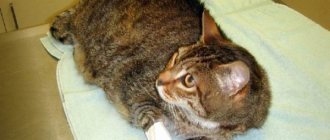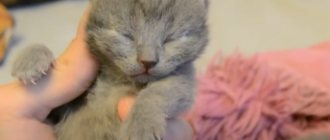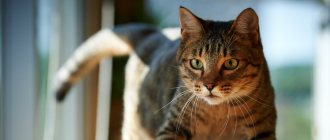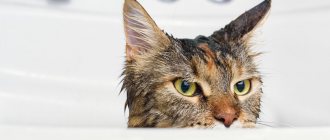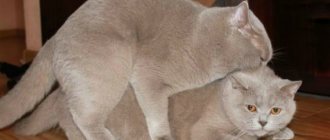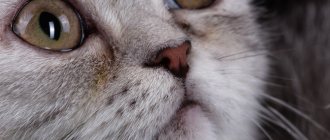The cat is limping after the injection: when will the lameness go away? The cat is limping after the injection, should I continue to inject?
Lameness in animals after injections appears quite often. If the pet owner notices that the cat is limping after the injection, then, if possible, it is worth showing him to the veterinarian. This is especially true if after the injection the cat limps for a long time.
Medical procedures such as injections are often prescribed by specialists not only to people, but also to pets. With their help, many modern ailments are treated. Injections can be used as an independent treatment or only part of a complex therapy. Animals, just like people, can react differently to the unpleasant procedure under discussion. Sometimes owners notice that the cat is limping on its hind leg after the injection. As a rule, exactly the one into which the medicine was injected.
Most veterinarians unanimously say that this is a completely harmless phenomenon. Usually, the unpleasant sensations in the animal’s hind leg disappear within a few days after the injection and the lameness disappears without a trace. In this case, no special measures need to be taken. You should be wary if the problem persists for more than 2 weeks. If the animal’s condition worsens, it gradually begins to step on its paw less and less, or it even feels like its hind limb is failing, then in this case you should see your pet to an experienced professional veterinarian as soon as possible. There is always the possibility that the injection was given by an incompetent doctor who performed the procedure incorrectly. Perhaps even seriously damaged a muscle. To avoid such troubles, you should seek help only from professional specialists.
Often, lameness after an injection appears in an animal when the procedure is carried out by the owner himself, who does not have any medical education or relevant knowledge and skills. In this case, you should not skimp on visiting the veterinary clinic and the problem will certainly be avoided.
By the way, the appearance of lameness in a feline after an injection is often associated with the medicine that was administered. To this day, inexperienced non-professional veterinarians continue to prescribe injections of “Drotaverine” (the more familiar name for us to the drug “no-spa”) to cats and cats, although this medicine is completely unsuitable for them and can lead to dangerous and serious consequences. That is why owners should carefully monitor the veterinarian’s prescriptions and, if necessary, adjust them.
For example, the medicine “Papaverine” is more suitable for domestic cats and cats, after injections of which no problems will likely arise. And possible slight lameness will completely disappear after 2-3 days.
Of course, we should not exclude other reasons that the cat began to limp after the injection. Perhaps this behavior is not at all related to the prescribed injection. Sometimes lameness in a pet can be a symptom of a variety of diseases. For example, related to joints or muscles. Therefore, if the problem does not go away within a few days, and the animal continues to limp and experience unpleasant painful sensations when walking, you should make an appointment with a veterinarian and, if necessary, undergo all prescribed examinations. Sometimes, to eliminate the problem, a specialist prescribes a special massage in a problem area, which can be done independently at home.
To exclude the possibility of damage to the paw on which the animal began to limp, it is worth carefully examining it. Perhaps the appearance of the problem simply coincided with the injection, but in fact the cat, for example, cut himself on glass while walking or got into a fight with other members of the feline family.
If the owner notices that his cat has begun to limp heavily on his hind leg after the injection, then this phenomenon should not be ignored. You will need to carefully observe the animal's behavior for several days and, if necessary, provide assistance.
Reasons for the development of abscesses after an injection
Any intramuscular injection is an invasive procedure. Such an intervention violates the integrity of the skin and triggers a whole chain of pathological changes. As a rule, the cause of an abscess is incorrect administration of injections in violation of the rules of asepsis and antisepsis. Often such complications occur if the injection was given at home.
Predisposing factors for the development of an abscess are decreased immunity and a sharp weakening of the body.
The correct way to administer the injection is to insert a needle into the upper outer quadrant of the buttock. It is permissible to inject the medicine into the muscle layer of the shoulder or thigh. If the syringe needle enters a large blood vessel, hemorrhage occurs into the soft tissue, which can lead to the development of an abscess. A number of drugs can have an irritating effect on tissue; when administered not into the muscle, but into the subcutaneous fat, it can also lead to the formation of an abscess.
If the wound at the injection site was scratched, this could serve as an entry point for infection and cause a suppurative process.
What symptoms do you see a surgeon for:
- Presence of hernial protrusion
- Daggering pains in the abdomen
- Bloating
- Pain in the right hypochondrium
- Bitterness in the mouth
- Nausea
- Presence of neoplasms on the skin
- Swelling and redness of the skin
- Bone fractures and bruises
- Wounds of any location
- Vomit
- Enlarged and painful lymph nodes
Why does a cat limp after an injection?
Surely, each of you is familiar with the expression: “We treat one thing, and cripple another.” This is exactly what many cat owners think when they are faced with the problem that the cat is limping after an injection. Sometimes this happens. Giving an injection can damage a cat's muscle or nerve. But such troubles do not always occur, because there are several causes of lameness and not all of them are caused by the ill-fated injection.
So what should you do if your cat has lameness after injections in the thigh? In the case when this does not last long, about two or three days, then there is no need to worry. This kind of lameness can go away on its own. But if you notice that your cat has been limping severely for 14 days, dragging its paw, or cannot stand on it at all, then it is certainly time to show it to the veterinarian.
Causes of lameness
There are several reasons that cause lameness in a cat. The most basic of them include :
- Incorrectly given injection . Often, unscrupulous doctors or even frivolous and risky owners themselves who decide to inject the animal themselves, when administering the injection, can get into the muscle incorrectly and thereby injure it. There are also cases where a cat, after an injection, limped for a month and dragged its hind paw behind it. And this all happened because an inexperienced veterinarian hit the pet in the sciatic nerve.
- The use of Drotaverine , a drug that is best known to us as no-spa. It is not always suitable for cats. Those with mustaches will prefer Papaverine. If you give an injection of no-shpa, you can provoke the appearance of such a problem as paresis in the animal. It won't go away on its own. In addition, with paresis, other symptoms may appear on the first day: shortness of breath, muscle spasms and excessive salivation. If you observe such a clinical picture, then, of course, you need to tell a specialist about it.
Diagnosis – coronavirus: subtleties of modern radiological diagnostics
It turns out that modern radiological diagnostic methods make it possible to distinguish joint pain caused by arthrosis of the knee or other joint from pain after coronavirus. Symptoms will also be different for influenza and Covid-19. Experienced diagnosticians pay attention to swelling and inflammatory changes in tissues, hematomas, dead tissue and other signs that confirm or deny the presence of an insidious virus in the body.
At the diagnostic stage, it is very important to understand what exactly caused joint pain and other symptoms: the virus itself or the body’s autoimmune reaction, since treatment depends on this.
Coronavirus releases harmful substances into the body that enter the synovial fluid, leading to inflammation of blood vessels and nerve roots. In this case, joint pain is treated according to one principle. If the virus is no longer in the body, but the pain remains, they talk about an autoimmune reaction or a relapse of a chronic joint disease: then the therapy will be completely different. Consulting an orthopedic surgeon is not enough. The patient needs to undergo an MRI or CT scan: based on their results, the rheumatologist determines the cause and draws up a treatment regimen.
“Covid fingers” – one of the complications of coronavirus
After the injection the cat is limping
05.07.2018
It’s possible, probably, in the mouth. I don’t know about the abscess, keep an eye on it, of course. My cat once lost her paw after an injection (in my opinion, noshpa) and basically dragged it like a rag.
And then, usually after the injection, the animals tighten their paws, the knee does not fall below the required level. Hello! Please tell me how long it takes for a cat’s paw to recover after a noshpa injection? Only 0.1 ml was administered intramuscularly, the cat screamed, broke free and ran away. They stabbed me in the thigh. She was poisoned on the 9th, so it’s not a matter of poisoning; her paws began to come off after the injections.
After the injection my leg hurts a lot. I can't walk, when I lie down or sleep I can't feel my leg. Your answers to this question did not help, what should I do? Remember once and for all! How can you help, if you exclude any injections, your hand will no longer rise to inject. She has been limping for 3 weeks now, she steps on her boot when walking, sometimes completely, sometimes her knee is just very drooping, she runs actively like a healthy person, we get massages, no lumps or pain.
Here, depending on what they were treating for. What poisoned the cat? How old is she, how many days has she been sick? Where did they inject her?
I was poisoned by something, I need to write first!
WILL THEY BE FEELING IN THE FEET?
She crawled (for the first time in all these days that she was sick) into her hole (they made it out of a box) and sat there. Who knows what the reason is?
We thought the effect was temporary.
Most likely the problem is no longer caused by the injection; there may be a problem with the musculoskeletal system (joints, ligaments, muscles). But let's start with the fact that paresis and lameness are two different clinical concepts. Good afternoon Usually, after an injection of any painful drug, there is an option - lameness, well, a maximum of a week.
The cat's paws gave out after the injection
I doubt they hit a nerve; they were looking for the meatiest place.
Later, Aibek’s parents learned that many similar cases had recently been registered in which children lost their legs after injections,” the report says. This is a small part of the links that can be found on the Internet, there is a problem, but YOU stubbornly do not want to hear about it! I don't know if you are a doctor or just the owner! Enough mistakes. When will the owners understand that not everyone is a “doctor”, as they call it... Why was Prednisolone prescribed?
Has anyone had this problem?
Also on this topic:
- Hematoma on the head of a newborn The laser destroys the growing vessels that make up the hematoma, which leads to the cessation of its growth. If the doctor uses a scalpel, the hematoma can be cut out entirely. Approximately
- Mantoux test and x-ray They tell us - if you don’t want to do mantoux, take an x-ray. As for the Mantoux test and other tests for tuberculosis, I am at your service. Mantu was made once, last year. Accurate
- Morning broadcastWhen are the latest episodes of the youth show Dom-2 released? Watch the next episode on the morning air daily at 09:00 Moscow time only on the TNT channel, write online publications. Love Reality House
After the injection my paw became paralyzed
Can lameness in cats develop due to infection with feline calicivirus (FCV)? which is one of the main causes of upper respiratory tract infections (colds) in cats.
The classic “cat cold” includes a short incubation period (three to five days) and manifests itself primarily in diseases of the upper respiratory tract (sneezing, runny nose, nasal discharge, conjunctivitis, discharge from the eyes and mouth). These symptoms may be accompanied by fever and, less commonly, cough and pneumonia.
Already in the early stages of the disease, some cats may experience transient lameness, which can be considered as a clinical sign of FCV infection. This is now believed to be a relatively common clinical manifestation of feline calicivirus infection. Transient lameness associated with cat infection with calicivirus is called Lameness Syndrome
(limping syndrome).
Calicivirus infection was identified as the cause of lameness in observations of infected kittens, in which lameness manifested itself within 2-3 days along with the usual symptoms of pyrexia, lethargy, and loss of appetite. Over the course of several hours, as hyperthermia developed, the kittens also exhibited general or localized stiffness, manifesting as lameness in some and almost complete immobility in others. Cats reacted painfully to palpating and manipulation of joints, and general hyperesthesia (pain or increased sensitivity to touch) was observed. None of the cats had sneezing or eye discharge, but about a third of the kittens developed mouth ulcers (one of the classic signs of feline calicivirus upper respiratory tract infection). Clinical signs resolved within 48 to 72 hours without residual effects.
Return of physical activity
Seriously ill patients with COVID-19 lie in bed for a long time. Inactivity weakens muscle tone and can cause neck and shoulder pain. Also, the lack of load reduces the mobility of the joints - the production of synovial fluid in them slows down. We talked about how this works in the article about joint problems. Some patients even find it difficult to maintain balance and walk. Therefore, doctors were puzzled by the issue of a speedy recovery.
“During almost a year of work with patients after coronavirus infection, we developed programs depending on the severity of the disease,” says Professor of the Department of Sports Medicine and Medical Rehabilitation of Sechenov University, Doctor of Medical Sciences. Elizaveta Koneva.
You can restore mobility with the help of physical therapy, which is prescribed in rehabilitation centers. There is no special exercise therapy program for post-Covid syndrome, but the nuances depend on the severity of the disease and complications.
“Motor rehabilitation after COVID-19 has no special features,” confirms neurologist and chiropractor at GMS Clinic Grigory Bashkirtsev. “For all people, the disease progresses individually, which means the approach to rehabilitation should also be as individual as possible, taking into account existing pathologies.”
For motor rehabilitation, for example, gymnastics is used to train balance and simple aerobic exercises in which a person uses the lungs and pulmonary muscles.
“Gymnastic exercises and hardware massage are mainly used,” says Koneva. During the recovery process, we take into account the patient’s complaints, monitor saturation and CT scans and, based on the data obtained, adjust the therapy.”
On the surface, all of these workouts may seem very easy to do, but after a long period of treatment, it can be difficult to even walk. Therefore, the entire process takes place under the supervision of rehabilitation specialists, who continuously monitor the patient and adjust the intensity of exercise therapy.
The effect of feline calicivirus infection on joints.
Further studies showed that calicivirus proteins could be found in the synovium (the membrane lining the surface of the joint cavity and the ligaments located in the joint) in cats infected with or vaccinated with the live FCV vaccine. Since viral proteins are associated with antibodies, we can talk about the formation of an “immune complex” (a combination of a virus protein and specific antibodies produced against it), which can provoke an inflammatory reaction. In some cases, the entire virus was isolated from the joints of cats with signs of calicivirus infection, including lameness, which can be considered evidence that the virus provoked an acute inflammatory reaction.
It is therefore clear that exposure to calicivirus, at least in some situations, results in a systemic infection causing localization of the virus in the joint tissues, which may cause an inflammatory response due to local replication in these areas, or perhaps due to stimulation of the immune system. mediated inflammation. Claudication syndrome is a form of virally induced polyarthritis (inflammation affecting multiple joints).
Some strains of FCV appear to be more likely to cause lameness in cats than others.
How was this discovered?
Recently, cases of patients who have suffered coronavirus infection turning to rheumatologists have become more frequent. This prompted scientists from Northwestern University in Chicago, in collaboration with Northwestern Medicine, to conduct a study. Attention was paid to those who, after Covid-19, developed atypical symptoms similar to arthrosis, osteoporosis, arthritis or other joint diseases.
Patients were examined using MRI, CT and ultrasound. The results showed that the cause of musculoskeletal symptoms, as well as joint pain, is the body's autoimmune reaction. Under the influence of coronavirus infection, the body seems to attack itself, and the attack is directed primarily at the moving joints. This is typical for most people, but not everyone copes with this reaction. If there is already a history of chronic joint disease, the body is weakened, the condition worsens, and with it the quality of life.
Joint pain after Covid is an autoimmune reaction of the body
The role of feline calicivirus infection in the development of lameness syndrome.
So, calicivirus is undoubtedly capable of causing temporary polyarthritis (inflammation affecting more than one joint) in cats, more often in small kittens. This is a fairly common manifestation of calicivirus infection, and sometimes lameness syndrome can be associated with vaccinations (especially live vaccines).
The severity of the syndrome varies widely, from subtle inflammation and slight limping to severe polyarthritis, where cats refuse to move, lose their appetite, and exhibit painful reactions when touched.
Affected cats gradually recover on their own, but if clinical symptoms are severe, anti-inflammatory drugs may be used for treatment. In addition, many other diseases can cause lameness besides calicivirus infection, and if the clinical signs are severe or persist for more than five days, you should definitely consult a veterinarian.
Which ones are needed?
Some people believe that if a cat does not walk outside, then vaccinations are not necessary. But that's not true. An infectious disease that is dangerous for animals can be brought home on shoes. If the animal is accustomed to walking, then it is necessary to carry out a complex of vaccinations. Mandatory vaccinations include distemper, rabies, feline herpes and calcivirus. At the owner's request, the cat is vaccinated against chlamydia.
The first vaccination of a kitten is carried out at the age of 8-10 weeks against rhinotracheitis, calcivirus, panleukopenia. Revaccination - after 3-4 weeks. Rabies vaccinations are given no earlier than 12 weeks and repeated annually. It is recommended to use the vaccine from the same manufacturer each time. Especially if the cat tolerates it well. Quarantine after vaccination lasts 10-14 days, it is during this period that immunity to the disease is developed. It is necessary to limit the kitten from being outside and from contact with other animals, especially unvaccinated ones.
Why is vaccination necessary?
It is important to have regular vaccinations for the following reasons:
If an animal is not vaccinated against rabies, then when it becomes ill, it becomes potentially dangerous to everyone.
- The diseases against which vaccines are created are deadly for animals. If an unvaccinated cat gets sick, then there is a high chance that everything will end in death.
- A sick cat poses a danger to other pets.
- Some diseases, such as rabies, are dangerous to humans. A cat can infect its owner. This disease is fatal to any living creature.
Return to contents
Dangerous consequences
Allergy to vaccine
If the animal is allergic, the injection is administered under the influence of an antihistamine. If there was no allergy to the first vaccination, this does not mean that it will not happen again. The substance can accumulate and cause complications in the cat after vaccination. Can be light or heavy. It manifests itself in the form of rashes, itching, swelling of the mucous membranes, and in severe cases - of the respiratory tract and internal organs. Rarely - anaphylactic shock. Requires immediate medical attention. There may also be hair loss, loose stools, vomiting, altered behavior, and the cat becomes lethargic.
The pet is limping
After vaccinations, the cat may develop lameness, a lump at the injection site, a lump, swelling, or a ball under the skin. These symptoms go away after a few days, but sometimes last a long time. May be due to inept administration of the vaccine by a veterinarian or an individual reaction. Sometimes when the drug gets into a nerve ending or vessel. If the injections are injected into a large nerve and it is damaged, sometimes the hind legs even fail.
Mild course of the disease
After vaccination, the cat may get sick. This occurs due to reduced immunity due to worms, inflammatory processes or indolent diseases. Vaccination should be carried out when the animal is in full health, and anti-worm tablets should also be given before it. If the cat had contact with sick pets, that is, when the quarantine had not yet passed, then it is not surprising that it became infected. During this period, the immune system is weakened.
Kidney failure
Scientists have identified the relationship between the complex vaccine and this disease. These drugs are produced from cat kidney cells. Action - once in the body, antibodies begin to be produced against the same kidney cells, destroying them. As a result, kidney failure occurs. The reason is frequent vaccinations. This complication occurs rarely.
Sarcoma after vaccination
A malignant cancerous tumor may develop at the site of vaccine administration. Called sarcoma. This happens very rarely. But such a formation grows quickly, and the result is that the cat died. This happens after a rabies vaccination that contains an adjuvant substance. Its actions are associated with causing an inflammatory process at the injection site and the formation of strong immunity. It is recommended to purchase vaccines without it. If the cat gets sick, in the early stages of the sarcoma an operation is performed to remove it, an injection is given intramuscularly into the paw - amputation is done.
Respiratory rehabilitation
A common complication after coronavirus infection is viral pneumonia. Due to fibrosis, that is, scarring, of the lungs after it, some patients experience breathing problems: shortness of breath appears, it is harder to walk and climb stairs, there is not enough air. Even doing simple household chores becomes difficult.
You can understand how serious the complications are by several signs: the amount of sputum produced, exercise tolerance, as well as measuring the volume of exhaled air over time.
Respiratory rehabilitation measures should be individualized, especially for people with comorbidities and the elderly.
“Patients after pneumonia need to restore the act of breathing with the help of breathing exercises. Restore the mobility of the ribs, thoracic region and diaphragm, and correct the mobility of the neck,” explains Grigory Bashkirtsev.
In addition to aerobic exercises that require rhythmic breathing, breathing training is used during rehabilitation. They also help regulate breathing rhythm and mobilize respiratory muscles that are weakened by lack of exercise.
What to do if complications occur?
If your cat has a reaction to vaccination, you need to take the following measures:
- If there is a lump or swelling at the injection site, doctors recommend massaging this area. Most often appears in the withers area. The same is done if the cat is limping.
- The lump turns into an abscess - antibiotics or surgery are prescribed to remove it.
- In case of nerve damage and paralysis, long-term therapy is carried out.
- If an allergic reaction occurs, you need to give your cat antihistamines. Anaphylaxis can manifest itself in the form of convulsions, loss of consciousness, and affects the gastrointestinal tract. If your pet feels sick or vomits, it may be a manifestation of an allergy. Urgent help from a veterinarian is needed with the administration of antihistamines and droppers to relieve intoxication.
- If the temperature rises, give an antipyretic.
If complications occur, you must inform your veterinarian.
Complications after injections in veterinary practice (part 1). Infiltrates, abscesses, phlegmons...
The topic of post-injection complications, as a rule, is not raised in a professional environment.
Why?
It’s just that for those who take this topic seriously, everything is already clear, and those who work according to the principle “it will do!” don’t “bother” with such “little things.”
The invention of disposable syringes significantly reduced the number of complications after injections associated with violations of asepsis and antisepsis, which somewhat dulled the vigilance of doctors
But... There is a growing (and, alas, not the first) new generation of doctors, both veterinary and, alas, humanities, who are not accustomed to carefully reading thick books, moreover, not intended specifically “for doctors.” After all, the technique of performing injections is the lot of middle staff; doctors have no business dealing with such “nonsense”; they have to think about what to do with the patient...
In addition, animal owners who learn to inject their pets on their own are also not always aware of the intricacies of this procedure, and there is no one to teach them.
Increasingly, post-injection complications are becoming a significant problem, especially for cat owners, and this is often due to a violation of the drug administration technique.
What complications after injections are most common?
Here is a list of the complications that occurred in my and my colleagues’ veterinary practice:
- Infiltration at the injection site
- Post-injection sarcoma of cats
- Abscess/cellulitis at the injection site
- Necrosis of surrounding tissues
- Phlebitis
- Paraphlebitis
- Allergic reaction at the injection site
- Pyrogenic reaction
- Systemic allergic reaction
- Air embolism of a vessel
- Fat embolism of a vessel
Below we will analyze each of the types of complications mentioned in this list. But, first, we recommend that you study the general rules for administering medications, compliance with which significantly reduces the likelihood of any post-injection complications.
What complications are caused by violating the rules of drug administration?
- When the rules of asepsis and antisepsis are violated, the following complications are most often observed: inflammatory infiltrate at the injection site, abscess and phlebitis.
- When irritating substances enter loose connective tissue: inflammatory infiltrate, sterile abscess/phlegmon, paraphlebitis or tissue necrosis, as well as post-injection soft tissue sarcoma (especially in cats).
- When cold substances get into the tissue (especially when using biological products, oil solutions and suspensions): infiltrates and post-injection sarcoma of soft tissues (especially in cats).
- If the technique for removing the needle is violated when irritating substances are introduced and these substances enter the thickness of the skin: necrosis of the skin around the injection channel, inflammatory infiltrate.
- When using expired or low-quality drugs, as well as in the presence of individual sensitivity to the drug: an allergic reaction at the injection site or systemic, eosinophilic infiltrate or pyrogenic reaction.
- When using drugs not intended for intravascular administration or when the technique of intravascular administration of drugs is violated: phlebitis, paraphlebitis, air or fat embolism of blood vessels.
Thus, if a specialist performing injections experiences a large number of post-injection complications, it is urgent to analyze the injection technique to identify the source of the complications.
Infiltration at the injection site
Infiltration at the injection site can occur as a result of a variety of reasons.
- If the administered substance has irritating properties (hypertonic solution, excessive acidity or alkalinity of the reaction, etc.), then an inflammatory reaction occurs in response to the introduction of such a substance.
- If, during the introduction of a medicinal substance, microorganisms enter the injection zone, then an inflammatory process occurs as a response to their introduction.
- If an allergic reaction occurs when a drug is administered, one of its components is an inflammatory reaction at the injection site.
The inflammatory reaction is manifested by increased blood circulation in the area of drug administration, effusion of the liquid part of the blood - serous exudate, and the release of immune defense cells from the blood vessels: neutrophil leukocytes, eosinophils, lymphocytes.
In a normal situation, even if a slight inflammatory reaction to the administration of a drug is present, this is accompanied by the effusion of serous exudate and the release of a small number of cells. This effusion dilutes the administered drug, and increased blood circulation at the site of the reaction promotes rapid absorption of the contents of the infiltrate into the blood. This infiltrate is called serous and quickly resolves.
Infiltration - tissue compaction, often painful, at the injection site - is a sign of an inflammatory reaction at the site of drug administration.
But it happens that the inflammatory reaction to the administration of the drug does not go as it should. The stage of effusion of serous exudate and a strong increase in blood circulation is reduced, and inflammatory cells come out in greater numbers and for longer than during a normal inflammatory reaction.
- This happens, for example, when the body's reactions are weakened or distorted as a result of illness or stress.
- This happens when you inject a cold drug. As a result of the administration of a cold drug, reactive vasospasm occurs and rapid resorption of the injected drug does not occur.
- This happens when the dose of an oil-based drug or in the form of a suspension administered into one place exceeds the tissue’s ability to quickly absorb this drug.
- This happens when severe irritation from the injected drug causes the death of surrounding cells and disruption of blood circulation in the injection area.
The most severe inflammatory reaction is observed when a substance intended for intramuscular or intravenous administration enters loose connective tissue (subcutaneous, perivascular or intermuscular fatty tissue). An abundant capillary network, large spaces between cells and many elements of connective tissue create opportunities for the rapid development of an inflammatory response.
But if the body’s reactions are weakened, then a significant increase in blood circulation does not occur, and the release of leukocyte cells can be prolonged for a long time. And after the leukocytes in the area of the inflammatory infiltrate, connective tissue cells begin to multiply vigorously, leaving a compaction in the area of the inflammatory reaction for a long time.
Signs of aseptic infiltrate:
- compaction at the injection site, which grows for 2-3 days, and then begins to gradually decrease and dissolve
- moderate pain in the area of compaction
- with intramuscular administration - a slight impairment of limb function (claudication), which gradually disappears
- body temperature is usually normal or slightly elevated,
- changes in appetite and thirst are usually not observed (except in particularly sensitive patients)
- there is no clear boundary between the compaction and surrounding tissues by the end of 4-5 days
The infiltrate remains for a long time when the force of irritation at the injection site exceeds the body’s ability to eliminate the consequences of the inflammatory reaction.
How to prevent the formation of infiltrates
Do not use drugs that have an irritating effect for subcutaneous administration. Use intramuscular administration (blood circulation in the muscles is stronger, and there are fewer connective tissue elements) or intravenous administration (if possible, and always in dilution) of such drugs.
Warm injected medications. This will reduce irritation of surrounding tissues, prevent spasm of capillaries and small vessels at the site of drug administration, and speed up the absorption of the injected drug.
How to deal with infiltration
If the infiltrate is not accompanied by itching and does not grow in size, then from 3-5 days after its formation, dry heat can be used to speed up its resorption. The easiest way to apply dry heat is to use sand or coarse salt. They can be heated in a frying pan or in the microwave and poured into a fabric bag or just a sock. This heating pad should be used for 15-20 minutes several times a day. Dry heat activates blood circulation and promotes rapid resorption of the infiltrate.
If the infiltrate area is itchy or the infiltrate itself continues to increase in size, heat should not be used!
In this case, it is worth taking a puncture from the area of infiltration for cytological analysis. Based on the results of this analysis, the necessary treatment will be recommended for the animal.
Abscess/cellulitis at the injection site
If the irritation is so strong that it causes the death of many cells at the site of drug administration or infectious agents are introduced into the injection area, then a purulent inflammatory process develops in response to this.
If this process is limited to a strong demarcation line of neutrophils and histiocytes and does not spread into the surrounding tissue, then an abscess forms. If the area of inflammation is limited only to the surrounding dense tissues (skin, fascia), then such inflammation is called phlegmon - diffuse purulent inflammation.
Signs of phlegmon and abscess at the injection site:
- increase in local and general temperature,
- increasing pain at the injection site and around it,
- increase and thickening of the swelling at the injection site in the first days, followed by softening in the center (abscess) or in several places (phlegmon),
- the animal may refuse to feed, an increase or sharp decrease in thirst, with phlegmon - signs of dehydration,
- if the injection is given intramuscularly, then the dog or cat tries not to use the affected limb,
- if the injection is subcutaneous, then there is often a “draining” of the purulent infiltrate below the injection site or its “spreading”.
In any case, purulent inflammation (abscess or phlegmon) is more painful and has greater systemic reactions than the aseptic infiltrate that we described above.
How to prevent abscess and cellulitis at the injection site
- Strictly follow the rules of asepsis and antiseptics. Wash your hands before preparing to administer medications.
- Do not use one syringe for sequential administration of several medications.
- Use sterile preparations, do not store open ampoules. If the medicine from one ampoule is planned to be divided into several injections, then the medicine should be immediately taken into several syringes and stored closed in the refrigerator.
- Keep the syringe needles in the cap until the moment of injection, do not touch the injection needles with your hands.
- For intramuscular and subcutaneous injections, it is not necessary to treat the injection site with an antiseptic, but it is very advisable to spread your hands or cut off the contaminated hair at the injection site. For intravenous, intraarterial and intraosseous injections, treatment of the injection site is mandatory.
How to treat purulent inflammation at the injection site
A doctor should carry out such treatment depending on the stage of purulent inflammation. In the initial stages, this may include novocaine blockades or other methods of physiotherapy; in later stages, this may involve opening and draining the purulent cavity.
To be continued…
Natalya Troshina, veterinarian (DVM)
Prevention
To minimize the risk, you must adhere to certain rules. The vaccination must be done by a specialist in the clinic, so that the cat is under the supervision of a doctor for an hour. It is necessary to check the expiration date of the vaccine. Injections should be given when the animal is healthy and not wormed. Adhere to the vaccination and revaccination dates. After vaccination, do not bathe, do not wash the injection site, and do not overcool. Be sure to comply with quarantine. During teething in kittens and pregnancy in adult cats, it is better to abstain.
The owner should monitor the pet's condition in the first week. The cat stopped eating and drinking, vomited, a wound or other symptoms listed above appeared at the injection site; this must be reported to the veterinarian. Only he will decide whether to take measures for treatment. If a cat vomits, this may be a common individual symptom, or it may indicate the onset of anaphylactic shock.
How to treat an abscess
The abscess is removed by a surgeon. If you do not seek medical help in a timely manner, this can lead to even more serious consequences for the patient.
- If the inflammatory process is infiltrative and non-purulent, conservative treatment is used. Physiotherapy, absorbable medications, and warm compresses are prescribed. It is recommended to lubricate the injection site with an alcohol solution of iodine.
- If pus begins to form at the site of inflammation, the doctor at our clinic will perform a puncture, remove the accumulated pus and rinse the cavity.
- If the abscess is deep, surgical treatment is performed. An incision is made at the site of the abscess, the cavity is washed and drained.
- In case of an extensive process and symptoms of general intoxication, treatment with antibiotics, immunomodulators, and vitamins is prescribed.
Qualified specialists at our clinic treat purulent inflammatory diseases using the most effective and safe methods and medications.
Diagnostic methods in surgery:
- Doppler in surgery
- Colonoscopy
- Angiography
- CT scan
- Gastroscopy
- MRI
- Abdominal ultrasound
- X-ray
- Endoscopy
Prices:
| Code | Name of service | Prices |
| 1 | Initial appointment | 1200 |
| 2 | Repeated appointment | 900 |
| 3 | Calling a surgeon to your home | 3500 |
| 4 | Abdominal ultrasound | 2200 |
| 5 | Ultrasound of veins and vessels | 2400 |
| 6 | Doppler 2-3 trimester | 1200 |
| 7 | Rectoscopy | 1500 |

